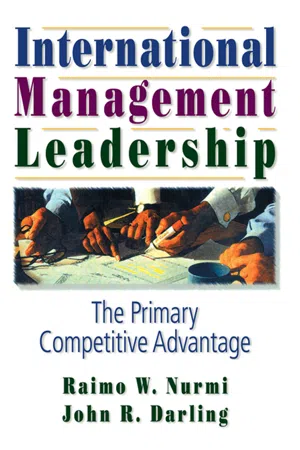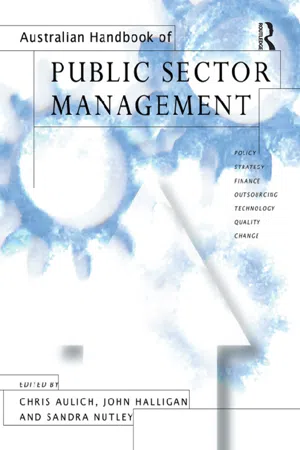Effective Management
Effective management involves the coordination and organization of resources, people, and processes to achieve the goals of an organization. It encompasses planning, organizing, leading, and controlling activities to ensure efficiency and productivity. Effective management also involves decision-making, problem-solving, and fostering a positive work environment to drive success.
5 Key excerpts on "Effective Management"
- eBook - ePub
- Lidia Varbanova(Author)
- 2013(Publication Date)
- Routledge(Publisher)
...On the other hand, organisational strategy considers the capacities and resources in all management areas. David (2011) 31 defines strategic management as the art and science of formulating, implementing and evaluating cross-functional decisions that enable an organisation to achieve its objectives. He stresses the importance of the functional areas and the need for strategic management to focus on integrating management, marketing, finance/accounting, production/operations, research and development and information systems to achieve organisational success. Chapter 3 discusses in more detail the need for collaboration between the top managers and the functional managers in the process of elaborating the strategic plan. 3.4. Phase IV: Implementation and Monitoring of the Strategic Plan This is one of the core management function, along with other management functions such as organising, coordinating, motivating and decision-making. It is important to constantly monitor current activities, resources, staff and deadlines. One of the main difficulties related to arts organisations is achieving a balance between the creative process and all other processes happening ‘backstage’ such as creative, operational, financial, marketing and managerial. During the implementation of the strategic plan it is important to constantly motivate all people involved—the staff, board members, executive director, artistic director, management body, volunteers and stakeholders. Motivation creates a sense of belonging to an organisation and an ongoing engagement which is an important basic factor for achieving the desired goals. The role of motivation in the strategic management process is discussed in Chapter 8. 3.5. Phase V: Strategic Reflection: Measuring Results—Evaluation, Control and Corrective Actions This phase is the last in the overall strategic management process...
- eBook - ePub
International Management Leadership
The Primary Competitive Advantage
- Erdener Kaynak, John R Darling(Authors)
- 2013(Publication Date)
- Routledge(Publisher)
...So the keys to organizational quality in a firm focus on three variables—care of customers, constant innovation, and committed people. Yet in this model of excellence, something is still missing—that one element that connects all the others. As noted in Figure 3.2, that one element is effective managerial leadership. Through the development and implementation of leadership strategies, the manager helps to facilitate the reflection of excellence in the organization (Peters and Austin, 1985). FIGURE 3.2. Model of Keys to Organizational Excellence MANAGEMENT VERSUS LEADERSHIP The primary factor that has prevented the creation of a culture of excellence in many international business firms is that they have tended to be overmanaged and underled. Managers in these organizations may excel in the ability to handle the daily routine, yet never question whether the routine should be done at all. In this regard, there is a profound difference between management and leadership, but one should readily recognize that both are important. To “manage” means to bring about, to accomplish, to have charge of or responsibility for, and to conduct. Leading is influencing, guiding in direction, course, action, and opinion. The distinction is crucial. Managers are people who do things right, and leaders are people who do the right things. The difference may be summarized as activities of vision and judgment, which facilitate effectiveness as a leader, versus activities of mastering routines, which facilitate efficiency as a manager. Thus, the degree to which managers are also leaders relates to how they construe their roles. Those who are successful view themselves as leaders, not just managers. That is to say, they concern themselves with their organizations’ dimensions of excellence in all respects. Their perspective is vision oriented (Bennis and Nanus, 1985)...
- eBook - ePub
Performance Management
Theory and Practice
- Susan Hutchinson(Author)
- 2013(Publication Date)
- CIPD - Kogan Page(Publisher)
...The chapter begins by examining some of the definitions of performance management, and considers how interpretations and the practice of the concept have changed over time. It then goes on to explore how performance management can be strategic and integrated, and some of the challenges in operationalising this model. One of the key difficulties is how to translate strategy into action, and the balanced scorecard is a recent development which helps managers demonstrate the strategic linkages. The chapter takes a critical look at this approach and then moves on to consider how performance management should work at the operational level – in other words, as a process of interlinked HR activities. The potential benefits of performance management as a strategic management tool are summarised, before the chapter concludes with a look at the role of the HR function in strategic performance management. WHAT IS PERFORMANCE MANAGEMENT? The use of the term ‘performance management’ varies enormously, and in the HRM literature a vast array of definitions are offered, ranging from the very simple – ‘Performance management is managing the business’ (Mohrman and Mohrman, 1995) – to the more sophisticated. For DeNisi (2000), it is a broad range of activities that an organisation engages in to enhance the performance of individuals, with the ultimate aim of improving organisational effectiveness. Others go further describing it as a strategic and integrated process which aligns individual, team and organisational goals. For example, Aguinis (2009): a continuous process of identifying, measuring and developing the performance of individuals and teams and aligning performance with the strategic goals of the organisation. Armstrong and Baron (in CIPD, 2009a) describe performance management as: a process which contributes to the Effective Management of individuals and teams in order to achieve high levels of organisational performance...
- eBook - ePub
- Sandra Nutley, John Halligan(Authors)
- 2020(Publication Date)
- Routledge(Publisher)
...This approach involves public managers taking a longer-term, broader view in order to anticipate and, if possible, shape changes in their environment. Their overall aim is to maintain the current and future viability of their organisation and to integrate typically diverse goals within a coherent and manageable framework. This strategic management approach, drawn from the private sector, has emerged within the APS as the preferred framework to meet government policy and operational requirements. Strategic management can be described as the process of defining, selecting and performing activities that improve the longer-term performance of an organisation. The process stems from a vision of the future and a clear mission for agency staff: it also matches internal organisational strengths and weaknesses against opportunities and threats in the external environment in which the organisation operates (Viljoen, 1994). Thus, the strategic management process relies on the organisation achieving the development of a number of activities which enhance performance (Exhibit 5.1). Through this, it links formally with performance management (see Chapter 11). EXHIBIT 5.1 Factors required for establishing an effective strategic management model A well-defined mission. An agreed set of agency goals and values. An information system which supports a cycle of analysing current strategy, determining directions, evaluating choices and implementing preferred strategies. As part of the strategic management concept, managers devise and put plans into action to meet specific goals, and use relevant feedback to evaluate and adjust performance against planned outcomes. This process is enhanced by the support and participation of staff who are able to identify and implement any changes to improve organisational performance (NPR, 1997). Public managers use the same basic management ideas and many of the same processes as their private sector counterparts...
- eBook - ePub
- Rob Dransfield(Author)
- 2013(Publication Date)
- Routledge(Publisher)
...Strategy involves complex high-level decision making and has major resource implications for a business. The strategy that a board selects needs to meet the criteria of suitability, acceptability and feasibility. The strategy is the means to achieve ends that are set out in the vision and objectives of the organization. In preparing, monitoring and evaluating strategies it is essential to continually scan the external business environment. The economic environment is perhaps the single most important external factor impacting on business decision making. The economic environment comprises changes in GDP and consumer spending, as well as a range of other important changes such as interest rates, exchange rates and wage rates. Changes in the economic environment present a key risk and uncertainty facing businesses. Key Ideas Some of the main points covered in this chapter are listed below. If you are unsure about any of them then revisit the appropriate section. If you would like some additional reading on the topic try the books listed below in recommended reading. What are business strategies? Businesses strategies are the means through which organizations achieve their objectives. Strategies involve long-term decisions that have major resource implications for an organization. The board of a company plays a key part in helping to formulate, question and monitor the effectiveness of strategy. Typically strategies relate to the longer period, although strategies should be flexible so that they can be adjusted in the light of changing circumstances facing an organization. Criteria for effective strategies Strategies should meet three main criteria: (1) they should be acceptable to stakeholders including shareholders; (2) they should be suitable to the environment in which a business is operating (e.g...




